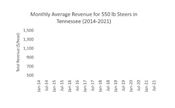Fall Calf Revenue Expectations
DR. ANDREW P. GRIFFITH
KNOXVILLE, TENN.
Cattle producers are heading toward the fall calf marketing period for winter and spring born calves. This means many producers are beginning to think about total revenue so they can compare that against their annual cost to calculate profits or losses for 2021. This profit or loss value is the primary indicator to determine if operating a cattle business was financially successful. However, if the total expected revenue is anticipated to result in a loss then producers can evaluate alternative marketing schemes to achieve a profit. Thus, it may be useful to look at what recent history has shown total revenue has done the past several years.
The chart included with this article illustrates the monthly average revenue of 550 pound steers in Tennessee from January 2014 through July 2021. It is clear producers really could not choose a bad time to market in 2014 and 2015 as cattle prices were high and profitability was practically a guarantee. However, from 2017 forward, total monthly average revenue generated by a 550 pound steer has ranged from $700 to $900 per head with October through December having the lowest values.
The average October value from 2017-2020 has been $758 per head with November averaging $760 per head and December averaging $763 per head.
This is compared to March, April and May when the average value has been near $825 per head.
The decision point today is determining if a producer should market cattle in the near term or if additional management should be contributed to the calf crop and marketed at a different time period.
The typical price decline from July to October has been 4.7 percent since 2017. Thus, if prices decline 4.7 percent from July 2021 into October then a 550 pound steer in Tennessee would be valued near $800 per head. Is this a profitable value? Heifer values will be less, which means the average revenue per calf marketed will be less than $800. This also does not account for failed pregnancies or death loss.
Will profitability be achieved this year? If not, what alternatives are there to try to achieve profitability? Should a producer take his or her loss or profit and move on to the next year? Are there longer- term changes that should be considered to increase the probability of making an acceptable return in the cattle business? The questions are practically endless, but many of them are worth answering. Carrying cattle to a heavier weight and a different marketing time frame does not always result in profits. Changing the breeding and calving season may not even do it. Producers should consider their strengths based on their resources and make decisions accordingly.
It is very possible that 550 pound steer prices will be in the $140 to $150 per hundredweight range, which will result in about $800 per head. Many producers’ annual variable costs are well below this value, but many producers total cost exceeds this value. What information can be gathered today to make better decisions tomorrow?
Maybe I can be a resource. ∆
DR. ANDREW P. GRIFFITH: Assistant Professor, Department of Agricultural and Resource Economics, University of Tennessee
